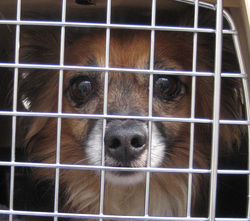
According to the American Society for The Prevention of Cruelty to Animals (ASPCA) estimates, “approximately 5-7 million companion animals enter animal shelters nationwide every year, and approximately 3-4 million are euthanized (60% of dogs and 70% of cats). Shelter intakes are about evenly divided between those animals relinquished by owners and those picked up by animal control.”
The National Council on Pet Population (NCPPSP) reports that less than 2% of cats and 15-20% of dogs are returned to their owners (most of these were identified with tags, tattoos or microchips).
(See http://www.aspca.org/about-us/faq/pet-statistics.aspx)
The National Council on Pet Population and Control reports that “the majority of dogs and cats relinquished are clearly adoptable”.
JOURNAL OF APPLIED ANIMAL WELFARE SCIENCE, 4(4), 237–248, Copyright © 2001, Lawrence Erlbaum Associates, Inc. (http://www.petpopulation.org/research_euthanasia.html)
|
|

It is not difficult to see that some of these reasons for relinquishing a pet might be eliminated by planning ahead. SEEK TRAINING. Using low cost vaccination clinics and purchasing Pet Insurance could provide relief from veterinary medical bills. Low Cost spay/neuter facilities would easy the number of unwanted kittens and puppies born each year. Assuring that your pet is identified with a collar tag, tattoo or microchip will help return your lost pet to his/her home. Provide for pets’ care in a trust or will in the event you can no longer care for them. Check limit laws and breed restrictions BEFORE bringing a pet into your home, get landlord approval if you rent. Take your pet to a day care facility or locate a dog walker if you have limited time to spend with your animal. Understand the breed or species before you choose a pet. NEVER give a pet as a gift unless you are positive the recipient is ready for and wants the responsibility of an animal. Investigate secure containment for your pet.
A pet is a thinking, feeling and needing creature. When you bring an animal into your family please be aware and ready to fill his/her needs. In return you will be repaid with unconditional love and many wonderful memories.

 RSS Feed
RSS Feed